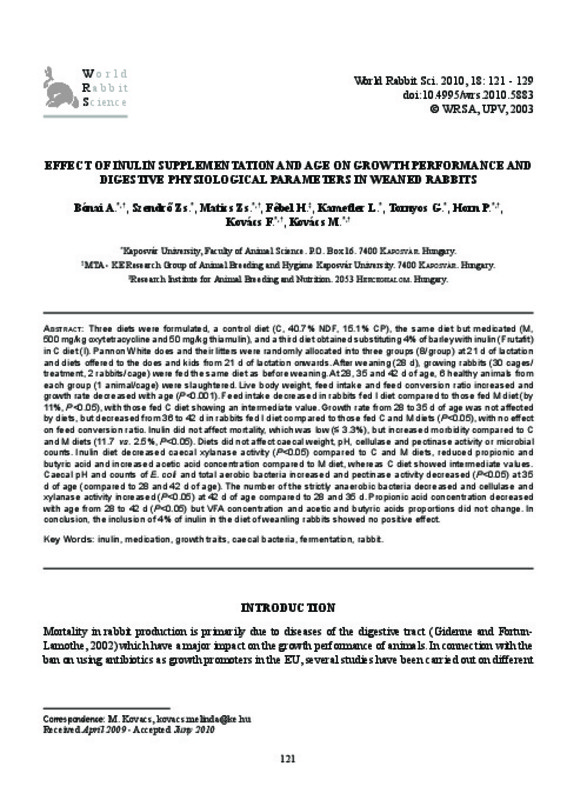JavaScript is disabled for your browser. Some features of this site may not work without it.
Buscar en RiuNet
Listar
Mi cuenta
Estadísticas
Ayuda RiuNet
Admin. UPV
Effect of inulin supplementation and age on growth performance and digestive physiological parameters in weaned rabbits
Mostrar el registro sencillo del ítem
Ficheros en el ítem
| dc.contributor.author | Bónai, A.
|
en_EN |
| dc.contributor.author | Szendró, Zs.
|
en_EN |
| dc.contributor.author | Matics, Zs.
|
en_EN |
| dc.contributor.author | Fébel, H.
|
en_EN |
| dc.contributor.author | Kametler, L.
|
en_EN |
| dc.contributor.author | Tornyos, G.
|
en_EN |
| dc.contributor.author | Horn, P.
|
en_EN |
| dc.contributor.author | Kovács, F.
|
en_EN |
| dc.contributor.author | Kovács, M.
|
en_EN |
| dc.date.accessioned | 2010-11-17T08:43:36Z | |
| dc.date.available | 2012-10-05T20:00:21Z | |
| dc.date.issued | 2010-10 | |
| dc.identifier.issn | 1257-5011 | |
| dc.identifier.uri | http://hdl.handle.net/10251/8943 | |
| dc.description.abstract | [EN] Three diets were formulated, a control diet (C, 40.7% NDF, 15.1% CP), the same diet but medicated (M, 500 mg/kg oxytetracycline and 50 mg/kg thiamulin), and a third diet obtained substituting 4% of barley with inulin (Frutafi t) in C diet (I). Pannon White does and their litters were randomly allocated into three groups (8/group) at 21 d of lactation and diets offered to the does and kids from 21 d of lactation onwards. After weaning (28 d), growing rabbits (30 cages/ treatment, 2 rabbits/cage) were fed the same diet as before weaning. At 28, 35 and 42 d of age, 6 healthy animals from each group (1 animal/cage) were slaughtered. Live body weight, feed intake and feed conversion ratio increased and growth rate decreased with age (P<0.001). Feed intake decreased in rabbits fed I diet compared to those fed M diet (by 11%, P<0.05), with those fed C diet showing an intermediate value. Growth rate from 28 to 35 d of age was not affected by diets, but decreased from 36 to 42 d in rabbits fed I diet compared to those fed C and M diets (P<0.05), with no effect on feed conversion ratio. Inulin did not affect mortality, which was low (¿ 3.3%), but increased morbidity compared to C and M diets (11.7 vs. 2.5%, P<0.05). Diets did not affect caecal weight, pH, cellulase and pectinase activity or microbial counts. Inulin diet decreased caecal xylanase activity (P<0.05) compared to C and M diets, reduced propionic and butyric acid and increased acetic acid concentration compared to M diet, whereas C diet showed intermediate values. Caecal pH and counts of E. coli and total aerobic bacteria increased and pectinase activity decreased (P<0.05) at 35 d of age (compared to 28 and 42 d of age). The number of the strictly anaerobic bacteria decreased and cellulase and xylanase activity increased (P<0.05) at 42 d of age compared to 28 and 35 d. Propionic acid concentration decreased with age from 28 to 42 d (P<0.05) but VFA concentration and acetic and butyric acids proportions did not change. In conclusion, the inclusion of 4% of inulin in the diet of weanling rabbits showed no positive effect. | es_ES |
| dc.description.sponsorship | The research was funded by the OTKA (project No. T046999) and the TéT foundation (project No. FR27/2007).The authors are grateful to Dr. L. Maertens (ILVO-Belgium) for his advice on diet formulation. | |
| dc.language | Inglés | es_ES |
| dc.publisher | World Rabbit Science. ICTA. UPV | es_ES |
| dc.relation.ispartof | World Rabbit Science | |
| dc.rights | Reserva de todos los derechos | es_ES |
| dc.subject | Inulin | es_ES |
| dc.subject | Medication | es_ES |
| dc.subject | Growth traits | es_ES |
| dc.subject | Caecal bacteria | es_ES |
| dc.subject | Fermentation | es_ES |
| dc.subject | Rabbit | es_ES |
| dc.title | Effect of inulin supplementation and age on growth performance and digestive physiological parameters in weaned rabbits | es_ES |
| dc.type | Artículo | es_ES |
| dc.identifier.doi | 10.4995/wrs.2010.5883 | en_EN |
| dc.relation.projectID | info:eu-repo/grantAgreement/Tet Foundation, Inc.//FR-27%2F2007/ | |
| dc.relation.projectID | info:eu-repo/grantAgreement/OTKA//T046999/ | |
| dc.rights.accessRights | Abierto | es_ES |
| dc.description.bibliographicCitation | Bónai, A.; Szendró, Z.; Matics, Z.; Fébel, H.; Kametler, L.; Tornyos, G.; Horn, P.... (2010). Effect of inulin supplementation and age on growth performance and digestive physiological parameters in weaned rabbits. World Rabbit Science. 18(3). https://doi.org/10.4995/wrs.2010.5883 | es_ES |
| dc.relation.publisherversion | https://doi.org/10.4995/wrs.2010.5883 | |
| dc.description.volume | 18 | |
| dc.description.issue | 3 | |
| dc.identifier.eissn | 1989-8886 | es_ES |
| dc.contributor.funder | Hungarian Scientific Research Fund | |
| dc.contributor.funder | Tet Foundation, Inc. |








